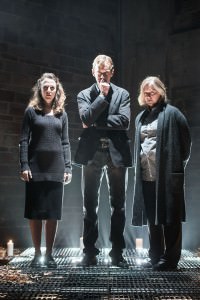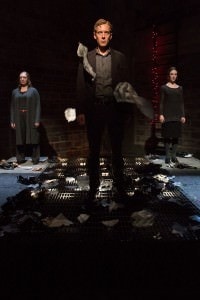
This is Part Two of Three of a discussion with the cast of Terminus at The Studio Theatre: Nanna Ingvarsson, Katie Ryan, and Dylan Myers, and their director Tom Story.
Michael: What made you want to approach this project?
Tom: Well, I’m just trying to direct as many things as possible, And I’ve directed three plays in less than a year, And this was offered to me by the Artistic Director of Studio Second Stage, Keith Alan Baker, And I read it, and I thought, “God, this terrifies me, and I have no idea how I would do it”. But I spoke with my mentors [Artistic Director of Shakespeare Theatre Company] Michael Kahn and [Founding Artistic Director of Studio Theatre] Joy Zinoman, and they said, “You have to do it – if it scares you, you have to do it. You have to keep pushing yourself as a director.” I thought the language of it was thrilling and I thought that I could figure out how to sculpt the acting, and so that was my way in to this play. I do a lot of language playsas an actor. I love language and I think I understand the power of it. I also knew I had to cast it right.
The language in this play is very poetic. How is approaching the poetry of this language different from approaching the poetry of, say, Shakespeare or Molière?
Nanna: There’s a lot of rhyme in the text. It’s very site-specific, but it’s not written in verse, per se. It has its own music, and I think the key is finding the moments where you can tell a story. There is so much storytelling in this play which is different from “oh I’m playing Othello.” It’s a balance between telling the story and working with the language – we’re still working on, but we’re getting there.

Tom: Yeah, it’s not easy. The text has Shakespearean demands.
How so?
Tom: The amount of images contained in the text is enormous. The language is very lyrical and sometimes graphically violent
Nanna: Oh yeah!
Tom: Grotesque and brutal.
This is the season where there are a lot of Christmas Carols and Nutcrackers. I understand this is a play about a serial killer. How will this play add to the holiday cheer this December?
Nanna: This play is the antidote to holiday cheer this December (laughter). If you had enough, and you need a palate cleanser, come see this play

Tom: It is not The Nutcracker or A Christmas Carol in any of its incarnations. I had this revelation about the play about a week into rehearsing, and I thought “there is something to doing this play at this time of year”. There are these three characters who are really lonely people, and at its core, it’s a play about how modern life isolates us. We search so desperately for connections, but are thwarted at every turn. And because of how we live, the devil is able to walk among us, in this urban world that we live. The play is set in the city, in Dublin, Ireland. For many, many people, the holiday season is one of the loneliest times of the year for many people, and the suicide rate skyrockets. So we are not denying the fact that we are doing this play at Christmas time; In fact, we’re embracing it, and when you see the play, you’ll know what I mean.
Is it difficult to approach the darker side of human nature? Is it exciting?
Katie: It’s fun (laughs) Like anything, it can be scary or a challenge to tap into, but, as in the Irish tradition, it’s written in such a funny, self-reflective way. Every time it gets to an incredibly dark moment, there’s just this funny pick up that happens immediately after, so it doesn’t shut the audience out. There’s something they can always latch onto. That’s been a relief.
Nanna: Yeah. I found that in terms of memorization, the toughest lines to learn were the brutal, graphic stuff. Once you get over that, you kind of start to relish it.

Katie: Yeah.
Nanna: And you have to approach it like that, because the language itself is fun. It’s something you want to chew on
Tom: It’s pleasurable.
Nanna: Yeah, in this really sick way.
Tom: And Nanna Ingvarsson has some of the most violent language.
Katie: Yeah.
Tom: I mean, Dylan Myers does too, but Nanna Ingvarsson has a sequence that is just… People moan during it (laughs).
Nanna: Oh yeah there was a big one last night (she imitates a huge moan).
So… This is not Theatre for Young Audiences.
Nanna: Oh, goodness no!
Some critics have drawn a connection between the playwright of Terminus, Mark O’Rowe, and other Irish playwrights like Connor McPherson, who also make use of extremely graphic violence as a part of their work. Do you see those parallels or do you think that Mark O’Rowe stands apart from these other artists?
Tom: People have talked about him in comparison with these other artists. I think that Mark O’Rowe has also talked about being bothered by Americans obsession with the violence in this works, which I understand. I think there is a different cultural response to violence in Ireland than in England and America. Americans may get really uptight about it but there’s a great Irish tradition of oral storytelling and he’s taking it and it’s no longer this folksy, let’s all sit around the fire and spin a yarn. It’s almost like hip-hop violent Irish rap.
I hope that made it on the poster.

Tom: So it’s like he took this very old form and synthesized it and made it very modern. I think that’s very different from all those other guys like McDonagh, This play is all spoken; there’s no blood on the stage.
Katie: Which is almost worse, though.
Tom: Yeah.
Katie: Because our imaginations are always bigger than anything we could ever show, which is why I think we get the moaning and the “oh no!”
Tom: I think you would ruin the play if you tried to show the violence.
American movies are known around the world for being very violent.
Tom: And Mark O’Rowe loves all those movies. Terminus is as violent as any of those Quentin Tarantino movies and probably worse. But you don’t see it, he makes you imagine it. You can see anything you want today. Millions of people saw the World Trade Center fall. It’s like the pornography of violence. But here it’s just described. To me, that takes it to a more primitive form of theater. I don’t know how a 15-year-old who blows zombies away all day with video games, I don’t know how he would deal with that
Nanna: Well, my son is coming to see it, and that’s exactly who he is.
Is there an “Irishness” to the play?
Katie: There are tons of references that we had to look up. But even besides the words used, there is something poetic and musical about it that is Different from American speech. I don’t know… there is something absolutely Irish about it. The darkness, the undertones of suffocation – Catholic guilt, perhaps.
Nanna: The characters themselves seem foreign to an American.
Tom: I agree. It certainly feels like it is Irish, but I don’t think you have ever had to be to Ireland to understand the core of it: loneliness and the need to connect. That’s actually what I find very fascinating about a lot of Irish playwrights, is that even though a lot of what they write about is very idiosyncratic, they are often very universal.
Katie: There’s a need to connect. It’s a very human needs that we can all latch on to.
Terminus plays through January 4, 2015 at The Studio Theatre’s 2ndStage – 1501 14th Street NW, in Washington, DC. For tickets, call the box office at (202) 332-3300, or purchase them online.
Running Time: One hour and 50 minutes, without an intermission.
LINKS
An Interview with Studio Theatre’s ‘Terminus’ Cast and Director: Part One: Nanna Ingvarsson, Dylan Myers, Katie Ryan, and Tom Story.
Review of ‘Terminus’ at The Studio Theatre. by Robert Michael Oliver on DCMetroTheaterArts.
John Stoltenberg on Terminus in his column ‘Magic Time!





